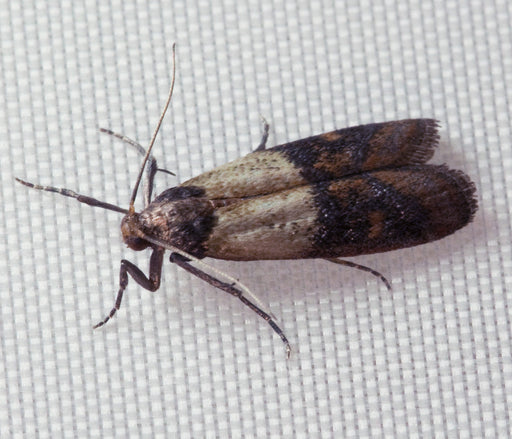The Indian Meal Moth - A Homeowners Guide

Kaldari, CC0, via Wikimedia Commons
The Indian Meal Moth (Plodia interpunctella) is sometimes referred to as the Food Moth or the Flour Moth. The Indian Meal Moth larvae (caterpillars) are commonly known as "waxworms". They are a common grain-feeding pest found around the world, feeding on cereals and similar products.
Adult Indian Meal Moths are 8–10 mm in length with a typical wingspan of 16–20 mm. The outer half of their forewings are bronze or dark grey in colour, while the upper half are a yellowy-grey colour, with a dark band between. The Indian Meal Moth larvae are off-white with brown heads. Fully grown Indian Meal Moth larvae are usually about 12 mm long.
 Sarefo, CC BY-SA 4.0, via Wikimedia Commons
Sarefo, CC BY-SA 4.0, via Wikimedia Commons
The entire life cycle of this species may take one month to 300 days with temperature being the main factor. Female moths lay between 60 and 400 eggs on food. These eggs (see photograph) are usually less than 0.5 mm and not sticky. The eggs hatch in 2 to 14 days. The larval stage can last from 2 to 41 weeks, depending on the temperature.
The Indian Meal Moth larvae can infest a wide range of dry foodstuffs of vegetable origin, such as cereal, bread, pasta, rice, dried fruits and nuts. The food they infest will often seem to be webbed together.
Pest Control
 Pudding4brains, Public domain, via Wikimedia Commons
Pudding4brains, Public domain, via Wikimedia Commons
After larvae or moths have been found, it is important to throw out all food sources that are not in very tightly sealed containers. The moths are able to get into surprisingly tight spots, including sealed bags and plastic containers. They are also extremely difficult to eliminate, and can crawl on ceilings and spin their cocoons in rooms other than the kitchen or food cupboards where they hatched. Indian Meal Moth larvae are able to travel significant distances before they pupate. When seeking the source of an infestation, the search should not be limited to the immediate area where pupae are discovered.
MothPrevention.com recommend the use of non-toxic pantry moth traps to inhibit the development of adult Indian Meal Moths and precipitate their eradication. See our range of Food Moth Products suitable for use in the kitchen.
MothPrevention.com provides a number of solutions to both eradicate pantry moths and their larvae, as well as preventing further food infestations.
Indian Meal Moth FAQs
Are you dealing with potential Indian Meal Moth infestations? If so, you probably have a few questions. Here are some frequently asked questions about these pesky moths to help you out!
Are Indian Meal Moths harmful?
No, Indian Meal Moths are not harmful to people. Even if you somehow ingested Indian Meal Moth larvae, you would probably be completely fine. The quantity of Indian Meal Moth eggs or larvae that you would have to eat in order to become ill would need to be quite substantial. With that being said, no one wants to eat moth larvae or eggs. So, you should definitely get rid of any kind of infestation that you have.
Where do Indian Meal Moths hide?
Indian Meal Moths like to lay eggs in secluded areas near abundant food sources. This could be a cupboard, camper van, bag of old flour in the very back of your pantry, or unsealed plastic bin with cereals on a dark shelf in your garage. Indian Meal Moth Larvae will then hatch and begin eating nearby dry goods until they grow large enough to spin cocoons. Often, they spin these cocoons in corners, cracks, and other wedge-shaped crevices.
Are Indian Meal Moths and Pantry Moths the same?
Indian Meal Moths and Pantry Moths are the same things. Indian Meal Moths fall into the subspecies Plodia Interpunctella. These insects feed on stored grains and dry food goods in the larval stage. Indian Meal Moths are also known by several other names including Flour Moths, Grain Moths, Mealy Moths, and Weevil Moths.
Why are there Indian Meal Moths in my room?
If you have an Indian Meal Moth infestation in your room, it is likely because the moth larvae are feeding on a hidden food source. Do you have cereals or chips stored under your bed? Are there crumbs in your dresser? Are your linens soiled with food remnants? These things can attract Indian Meal Moths.
What do adult Indian Meal Moths look like?
Generally, Indian Meal Moths showcase a few shades of brown and a specific pattern. The lower half of the wings are a darker shade of brown with a lighter shade of tan or gray at the top. The head of the Indian Meal Moth is usually the same dark brown color as the lower half of the wings.
These moths measure about 3/8 of an inch long. Adult Indian Meal Moths have a wingspan of about 5/8 of an inch. They have an oval-shaped body that is elongated as well. The colors of the Indian Meal Moth can range from dark mahogany to a rusty shade of bronze. Sometimes, these moths also have black stripes.
What do Indian Meal Moth Larvae look like? What about eggs and cocoons?
The larvae of the Indian Meal Moth will resemble little tan, cream, or white worms (caterpillars) with brown heads. The cocoon of an Indian Meal Moth will usually be brown and hard to the touch. Indian Meal Moth eggs are nearly invisible to the naked eye. However, they are a whitish color and may be surrounded by sticky webbing.
Are Indian Meal Moths hard to get rid of?
Getting rid of Indian Meal Moth infestations can be difficult. However, these moths are not impossible to get rid of. Moth Killing Sprays and Moth Traps are helpful for eliminating these pests. Essential oils and herbal sachets can also be helpful moth deterrents.
Herbal sachets with lavender, thyme, mint, and clove can help you keep these moths away. To eliminate them you will need professional based products such as a moth killing spray which is included in our Pantry Moth Killer Kit along with Moth Traps to help break the breeding cycle... Just be sure to use any pesticide products safely around your food items. You may also want to consider storing uninfested goods in your freezer until you have an infestation under control.
About MothPrevention
MothPrevention® speak to customers every day about their clothes moth issues - clothes moths are a species that are ever increasing and that can cause significant damage to clothes, carpets and other home textiles.
To date, we’ve helped over 250,000 customers deal with their moth problems. We have developed professional grade solutions including proprietary pheromones and trap design engineered to the highest production standards.





